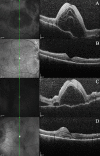Presumed occult globe rupture resulting in sympathetic ophthalmia
- PMID: 22200914
- PMCID: PMC3438300
- DOI: 10.1007/s12348-011-0056-4
Presumed occult globe rupture resulting in sympathetic ophthalmia
Abstract
Introduction: Sympathetic ophthalmia (SO) is an uncommon bilateral granulomatous panuveitis following uveal trauma to one eye. We present an unusual case of SO which resulted from presumed occult globe rupture following blunt trauma; and highlight the association of trauma and acquired external ocular pigmentation as a possible predictor for SO.
Case report: Five weeks following blunt trauma to the left eye (OS), a 30-year-old patient presented complaining of spontaneous blurred vision (4/60) in the right eye (OD). In the OD, there was anterior chamber and vitreous inflammation (3+), multiple areas of serous retinal detachments, Dalen Fuchs spots, and optic disk swelling. In the OS, there was iridodialysis, post-traumatic acquired external ocular pigmentation suggestive of occult globe rupture. This was diagnosed as SO and treated with systemic steroids and a steroid sparing agent; which resulted in resolution of the inflammation with improvement in the visual acuity.
Conclusion: Sympathetic ophthalmia has been reported to occur following penetrating eye injury secondary to trauma and surgery, and also secondary to non-penetrating eye trauma. This case reports SO occurring after presumed occult globe rupture; and reinforces the association between acquired external ocular pigmentation and SO in the context of trauma.
Figures



References
-
- Werner MS, Dana MR, Viana MA, Shapiro M. Predictors of occult scleral rupture. Ophthalmology. 1994;101(12):1941–1944. - PubMed
LinkOut - more resources
Full Text Sources

